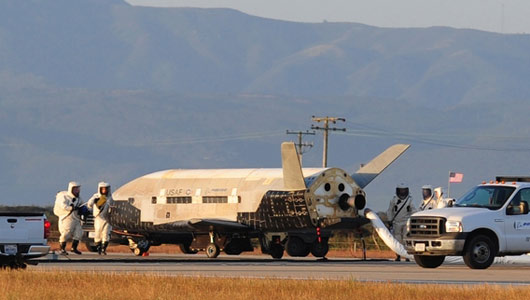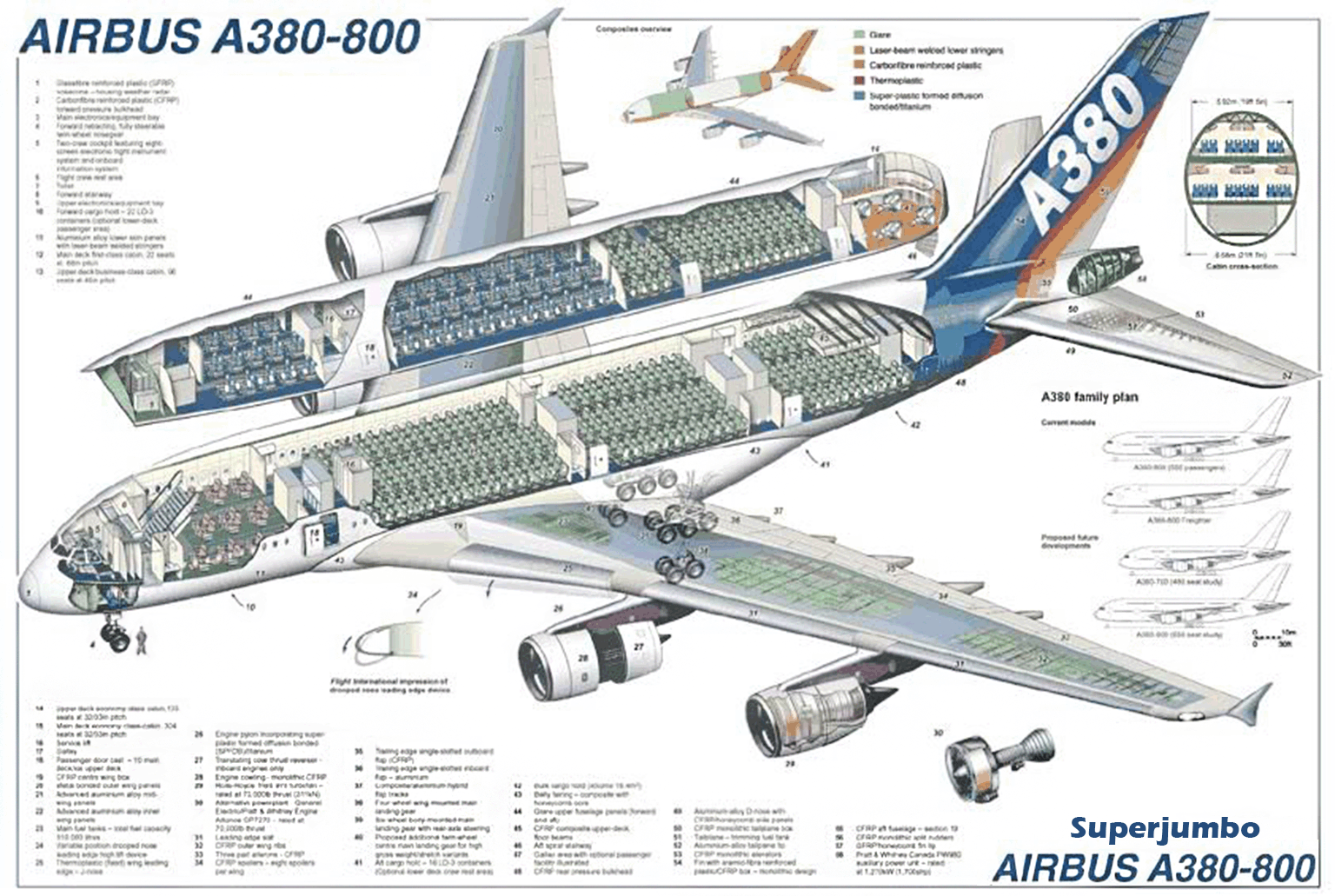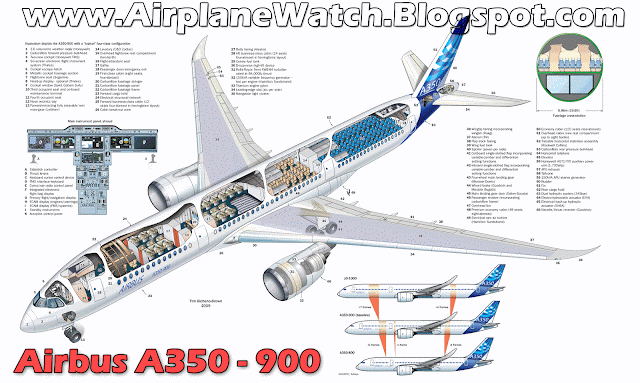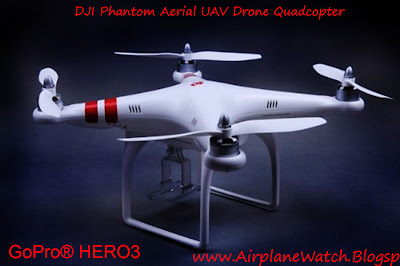"There is no one on the ground with a joystick flying it," Lt. Col. Troy Giese, X-37B program manager in the Air Force Rapid Capabilities Office, said before the first X-37B mission blasted off last year.
 |
| The Air Force's X-37B robotic space
plane sits on the runway after landing at California's Vandenberg Air
Force Base on June 16. The plane was in orbit for more than 15 months on
a classified mission. (Photo: Boeing) |
The X-37B looks like NASA's now-retired space shuttle, only much smaller. The vehicle measures just 29 feet (8.8 meters) long and 15 feet (4.5 m) wide, with a payload bay about the size of a pickup truck bed. For comparison, two entire X-37Bs could fit inside the payload bay of a space shuttle. It is designed to launch vertically inside the nose cone of a rocket, stay in orbit for months at a time, and then land horizontally on a runway like a space shuttle.
But unlike NASA's shuttles, the X-37B space plane does everything autonomously. It also has a solar array that is deployed from its payload bay to generate power during its months-long stay in orbit
The X-37B, also known as Orbital Test Vehicle-2 (OTV-2), launched on March 5, 2011, from Florida's Cape Canaveral Air Force Station. Its flight was the second-ever space mission for the X-37B program; the first was flown by OTV-2's sister ship, OTV-1.
OTV-1 stayed aloft for 225 days in 2010, well under the supposed 270-day orbital limit for the space plane. But OTV-2 smashed that limit, zipping around our planet for 469 days.
The X-37B's payloads and mission details are classified, so it's unclear exactly what OTV-2 was doing up there for so long. But Weeden thinks the Air Force's claim about technology-testing is broadly accurate.
Based on OTV-2's orbit — which is also classified but was figured out by keen-eyed amateur astronomers — Weeden reckons the space plane may have been staring down at Afghanistan and the Middle East with some brand-new spy gear, perhaps sensors that can see in wavelengths beyond the visible spectrum.
But China seems dubious of the Air Force's explanation, suspecting that X-37B missions might have a more aggressive intent.
 |
| The X-37B appears to be undergoing safing procedures after landing on
Dec. 3 at 1:16 a.m. PST (0916 GMT). Significant weathering, or
discoloration, can be seen on the spacecraft's upper thermal blanket
insulation. (Photo: USAF/Vandenberg) |
"Industry analysts said the spacecraft could be a precursor to an orbiting weapon, capable of dropping bombs or disabling enemy satellites as it circles the globe," China's state-run Xinhua news agency wrote on June 17, a day after OTV-2 touched down at Vandenberg Air Force Base.
China views the X-37B "as a perfect example of the U.S. developing a space weapon program while stating in public that they're doing no such thing," Weeden told SPACE.com.
Just hours after China's Shenzhou 9 capsule roared into space on June 16, 2012 with three astronauts aboard, including the nation's first female spaceflyer Liu Yang — the U.S. Air Force's robotic X-37B space plane touched down in California after 15 months orbiting Earth on a hush-hush mission.
The Air Force insists the X-37B is just testing out technologies for future satellites, but China has a deep suspicion of the vehicle and its activities, experts say.
"The X-37B is actually very controversial over there," said Brian Weeden, a technical adviser with the Secure World Foundation and a former orbital analyst with the Air Force. "They view it as a space weapon."
The Shenzhou 9 capsule, for example, linked up with the unmanned Tiangong 1 module on June 18 and again on June 24, making China just the third country — after the United States and Russia — to pull off a manned space docking.
Shenzhou 9's mission, which is expected to wrap up by June 29, 2012 is viewed as a key step in China's plan to build a permanently staffed space station in Earth orbit by 2020. The country hopes to land a taikonaut on the moon sometime after that, and it's also developing its own satellite-navigation system so as not to be dependent on the U.S.-military-run GPS network.
China's suspicions about the X-37B may not make American officials too happy, for they've stated a desire to engage the Chinese more fully on space issues going forward.
"The U.S. says they're very interested in military-military dialogue with China on space activities, and further cooperation with China in a few different areas," Weeden said.
Secret second test flight
Air Force officials have not said much about first X-37B mission, and they're been similarly tight-lipped about the upcoming second flight with the OTV-2 vehicle.
But the Air Force has said that the X-37B spacecraft should help the Air Force test and demonstrate new technologies — such as guidance, navigation and control systems — that could be used on future satellites.
The secrecy surrounding the X-37B has led to some speculation that the plane could be a space weapon of some sort. But Air Force officials have repeatedly denied that charge, and some experts have postulated that it is a platform for space reconnaissance.
The X-37B was built by Boeing's Phantom Works Division in Seal Beach, Calif., and can fly long, extended missions because of its solar array power system, which allows it to stay in orbit for up to 270 days, Air Force officials have said.
Originally, NASA used the space plane as an experimental test bed until funding for the project ran out in 2004.
The vehicle then passed to the Defense Advanced Research Projects Agency and was ultimately turned over to the Air Force in 2006.
This article was reprinted with permission from SPACE.com.
Copyright 2013 SPACE.com, a TechMediaNetwork company. All rights reserved.








